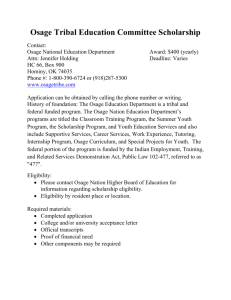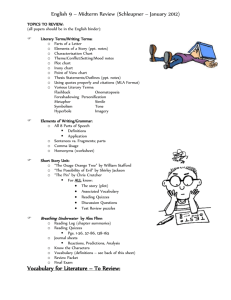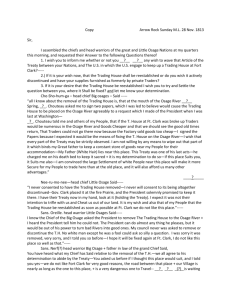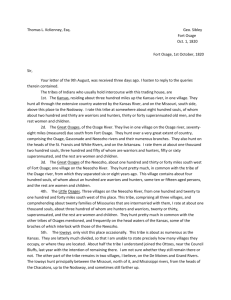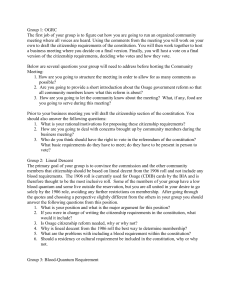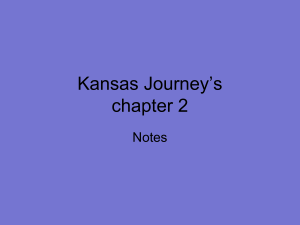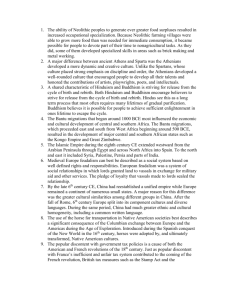The_will_of_the_people_Osage_
advertisement
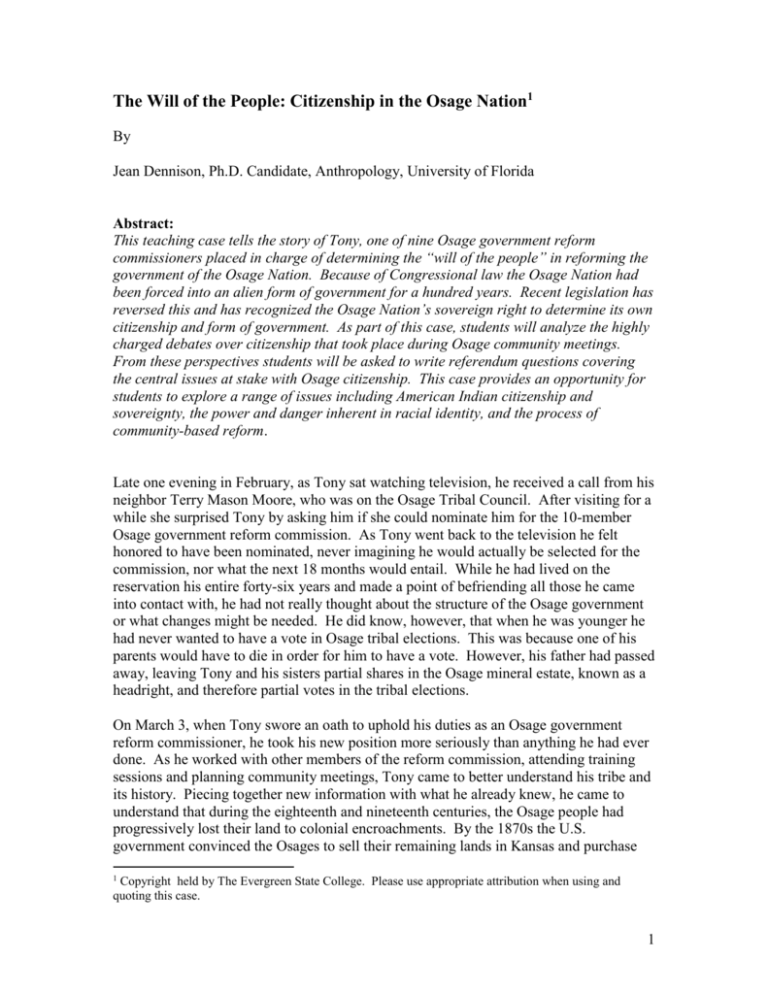
The Will of the People: Citizenship in the Osage Nation1 By Jean Dennison, Ph.D. Candidate, Anthropology, University of Florida Abstract: This teaching case tells the story of Tony, one of nine Osage government reform commissioners placed in charge of determining the “will of the people” in reforming the government of the Osage Nation. Because of Congressional law the Osage Nation had been forced into an alien form of government for a hundred years. Recent legislation has reversed this and has recognized the Osage Nation’s sovereign right to determine its own citizenship and form of government. As part of this case, students will analyze the highly charged debates over citizenship that took place during Osage community meetings. From these perspectives students will be asked to write referendum questions covering the central issues at stake with Osage citizenship. This case provides an opportunity for students to explore a range of issues including American Indian citizenship and sovereignty, the power and danger inherent in racial identity, and the process of community-based reform. Late one evening in February, as Tony sat watching television, he received a call from his neighbor Terry Mason Moore, who was on the Osage Tribal Council. After visiting for a while she surprised Tony by asking him if she could nominate him for the 10-member Osage government reform commission. As Tony went back to the television he felt honored to have been nominated, never imagining he would actually be selected for the commission, nor what the next 18 months would entail. While he had lived on the reservation his entire forty-six years and made a point of befriending all those he came into contact with, he had not really thought about the structure of the Osage government or what changes might be needed. He did know, however, that when he was younger he had never wanted to have a vote in Osage tribal elections. This was because one of his parents would have to die in order for him to have a vote. However, his father had passed away, leaving Tony and his sisters partial shares in the Osage mineral estate, known as a headright, and therefore partial votes in the tribal elections. On March 3, when Tony swore an oath to uphold his duties as an Osage government reform commissioner, he took his new position more seriously than anything he had ever done. As he worked with other members of the reform commission, attending training sessions and planning community meetings, Tony came to better understand his tribe and its history. Piecing together new information with what he already knew, he came to understand that during the eighteenth and nineteenth centuries, the Osage people had progressively lost their land to colonial encroachments. By the 1870s the U.S. government convinced the Osages to sell their remaining lands in Kansas and purchase 1 Copyright held by The Evergreen State College. Please use appropriate attribution when using and quoting this case. 1 reservation land from the Cherokees in Oklahoma. In 1881, shortly after their relocation to northeastern Oklahoma, the Osages adopted a constitutional form of government. Building on a national identity that had been in existence for centuries, the Osages intended this new constitution to provide written property protection and to mediate disputes with other tribes residing nearby. However, in 1900 the Bureau of Indian Affairs (BIA) abolished the Osage government and appointed its own Osage leaders in hopes of allotting the Osage Reservation as part of their policy of assimilation. Because the Osages had purchased their lands they were not subject to the Dawes Allotment Act that forced the breakup of other tribal lands. They were, however, eventually persuaded to accept allotment anyway. The government formed by the BIA in 1906 to administer the mineral estate was originally intended to last for only 25 years at which time the BIA assumed that the Osage people would be acculturated into the mainstream, eliminating any need for a tribal government. As Federal policy changed, however, the mineral estate of the Osage tribe was extended into perpetuity. While most of the land allotted in 1906 is no longer held in Osage hands, the Osage tribe continues to own all the mineral rights on lands within the Osage reservation and has an income from all oil and gas produced in the territory. When the land was allotted in 1906, the Osage tribal roll had four qualifications for admission: Osage blood in any quantum, local residence or continued affiliation, enrollment prior to December 31, 1881, and proof of birth prior to July 1, 1907. However, Osage leaders at the time argued that 244 of the 2,229 people put on the roll had been included fraudulently. While some people without Osage blood had been included because they had been adopted into the tribe, others had bought their way onto the roll. The Federal government refused the Osage leaders appeal and continued to use the full 1906 roll as the basis of determining membership in the tribe, which included a 640-acre land allotment, a headright share in the extremely profitable mineral estate2, and a vote in tribal elections. Those born after July 1st, 1907, however, were not given any part of the Osage estate nor a vote in tribal elections. This would only change if a relative were to pass away and leave them part of their share in the mineral estate. This system often created two different classes of people within a single Osage family. One common example of this occurred when the oldest sibling was an original allottee, meaning they were listed on the 1906 roll, but the other siblings were born after the July 1st, 1907 cut-off date. All those listed on the roll, no matter what their age, were given four-160 acre parcels of land within the Osage reservation, 1/2229th share of all monies produced from the mineral estate, and a vote in tribal elections. Any Osage born after the 1907 cut-off date did not receive anything and had no voice in the tribal elections. It was only upon the death of a person holding a share in the mineral estate that these disenfranchised people could gain access to the land, money and the ability to vote. Often when a parent would die they would will equal parts of their mineral share to each of children. If there were two children, they would each get 1/4458th of a share in the 2 The income from mineral extraction was equally divided into per capita payments, which for the Osage are known as shares or headrights. 2 mineral estate and half a vote in tribal elections. Additionally many headrights left the tribe in the 20-year period when the mineral estate headright were considered like any other piece of property and thus could be willed to anyone or any organization. Thus many churches, lawyers and even some famous actors ended up with shares in the mineral estate. This did not give them a vote in tribal elections, but it did keep some Osage descendants from voting. On the other hand, the headright system of membership did create a sense of legitimacy for Osages who did hold a share in the mineral estate. Because many people of Osage descent would eventually inherit a headright it was thought that those without a headright simply needed to wait their turn. Likewise, the fact that parents and grandparents were often those who held shares, it was argued that this system allowed elders to make decisions based on their more mature understanding of Osage politics and history. Furthermore, since the headright system was linked to quarterly financial payouts from the sale of oil on the reservation, all attempts to open up membership were challenged as merely attempts to redistribute this money. In the century following the 1906 Osage Allotment Act, being Osage was partially defined by descent. While all descendants of the original 1906 allottees are eligible for a Certificate Degree of Indian Blood (CDIB) card from the BIA, the voting citizens of the Osage tribe continue to be only those people who hold a headright share in the mineral estate, regardless of their residence, blood-quantum or affiliation with the Osage tribe. As a result those people of Osage descent with living parents or whose parents, grandparents or great-grandparents did not, for various reasons (including fraud) pass on their mineral estate rights, have not been eligible to vote in Osage affairs or run for office. By the 21st century this form of government had left nearly 16,000 of the approximately 20,000 people with Osage ancestry without voting rights and had alienated them from tribal politics. This alienation was the principal motivation for attempts at reform that led the United States Congress in 2004 to pass a law recognizing the Osage Nation’s inherent sovereign right to determine their own membership and form of government. After holding a sovereignty celebration on February 4, 2005 the Osage Tribal Council created the Government Reform Commission and set them on the task of determining the will of the Osage people. At first Tony felt overwhelmed with all the new information to be processed and the difficulty of the commission’s job. The commission, as he now understood it, was responsible for holding community meetings, establishing a webpage and using other media to collect and disseminate information about the reform process. In addition, the commission was responsible for surveying the Osage population and collecting opinions about how citizenship ought to be determined and what shape the tribal government should take. Once the commission had gathered this information they were supposed to create a series of referendum questions, which would be voted on by the Osage people determining the contents of the constitution. Finally the Osage people would vote on the proposed constitution. 3 Tony wondered what he could offer to the reform process. All the other commissioners seemed to have particular skills, such as a background in tribal governments, institutional knowledge of the Osage tribe, or a law degree. Finally, after many late night conversations with his family and members of the commission, Tony decided he did have something very valuable to contribute. He was going to make sure that as many Osages as possible had input into this new form of government. The Commission began their work in March. It is now nearing the November 19 referendum election. Many of the questions have been drafted, but the citizenship questions are proving difficult to write. Because the commission knows they have to keep the referendum short and simple, they agree that there can only be a few questions dealing with citizenship. However, Tony wants the constitution to represent the will of the Osage people and therefore wants to include as many of the important issues as possible in the referendum. What questions could Tony and the Commission write on citizenship in order to cover the range of issues addressed in the community meetings? 4 Testimony Gathered From Community Meetings Those Opposed to a Blood Requirement for Tribal Membership “I think that there should be no blood quantum. If we stop now and try to clean up our roll, it is going to bog us down and we'll be bogged down for the next 50 years and never accomplish a thing and not get a membership…. If you take another tribe, say across the river, the Poncas … right now they are dealing with lowering their membership quantum. I think that all the tribes are going to have to do that eventually if they have one set at one quarter because we are living in a time period where people marry other races and other tribes and so the blood lines are really thinning out.” “It (citizenship) is who you are culturally and socially, I think. To me blood has very little to do with it. We have people that live right here that, or maybe I should say, people that live away from here who are more Osage than some people that live right here in the community because those people are recognized as Osages, culturally.” “It is important to remember that Indian Nationhood is not a racial or ethnic matter, it is a political status. So blood quantum should be irrelevant. Being Osage is more of a state of mind; it is being part of a community.” “I guess it is a difference if we call ourselves Osage tribe, or are we Osage Nation. Whether it is a nationality or it’s just an ethnic background. For me, I am Irish, French, Osage, I probably got something else mixed in there. But, my identity is with the Osage, I consider myself Osage. I think that is an important distinction, especially in our country with so many Indian tribes and so many people mixed together, it’s how the tribe wants to be in the long run.” “The Bureau of Indian Affairs is in the business of going out of business; we are in the business of ensuring the future. It is our inherent right to determine our membership and our responsibility to ensure it lasts for as long as an Osage draws a breath.” “Blood is a BIA genocide policy.” “No blood quorum [sic] should be considered in determining who is Osage. Mine is incorrect on the roll “I kid a lot of them who think they are half blood, ok if we get down to this nut cutting and fighting over this blood quantum, I am going to tell them who their great 5 grandmother was. Because I can also do fractions. I know some who claim full half blood status who are 29/64ths and that is not a half. I can do fractions good. Them old people did not do them too good. Like my grandpa his oldest brother on the rolls was 3/8ths he was almost a quarter and the other was on as an eighth and they all had the same mom and daddy.” “The Federal Government bases program needs off the numbers, how many people are in need. So if you cut people out of the tribe then you may be cutting yourself off for certain funding that a tribe may be eligible for all kinds of programs, including housing.” “The blood issue that seems to come up in every Indian Nation is a slippery slope for our people. This is a white man’s game. We as original human beings never thought of blood; we thought of family and deeds. We adopted others into our tribe and treated them with love and respect as equals. There are no full bloods, so by thinking of degrees of blood then there are no more Osage people either. I feel that blood degree is a form of discrimination. We need to be Indians not white Indians.” “We should all be cautious about setting a blood quantum level. By doing this we kill our own tribe’s identity. The reality of blood levels is, after decades only a handful of Osage will remain – then none.” “Treat all of us equally regardless of our blood quantum; it’s not our fault.” “I know there are other rolls out there, but the CDIB cards are tied to the 1906 roll…There are no rolls that Osages created, they were all created by the BIA” Support For a Blood Requirement “By 1906 clearly it was obvious that if you could get on the roll it might pay off, which of course it did. So I would say as a personal thing I would think that the 1901 roll would be more reliable as to who was more likely to be culturally identified as Osage. By 1906 it is pretty demonstrable that a number of people who are on the 1906 roll are not of Osage blood.” “Let’s face it, you ought to be Osage to be a member of the Osage tribe. But if they can prove that you’re not, then why do you want to be part of our tribe…If you want to be a member of the tribe you should be of Osage blood.” 6 “There are some families that go around here and say that they know they are not Osage. But they said they sure will use what we give them. I believe not all are like that, but I just feel that when you have a tribe and membership that it should be by blood. Yes, they did adopt a lot in the Osage Tribe. I just don’t think that it is right that they get a vote or anything when our own Osage children don’t get much not because of how many of the adopted ones and people that were on by fraud get the same as an Osage by blood. I am not saying people can’t feel like they are Osage. It is different to feel than to actually be an Osage by blood. I have several friends that are really not Osage, and I feel that they are taking away from my children. I am not trying to make anyone mad but just telling my feelings on it.” “Somewhere in our records we have a number of people in the 1906 Act that were Osage blood and a number of people that weren’t. And it’s amazing at how many people in the 1906 Allotment act were allowed on the so-called allotment on the Indian roll that were not of Indian descent. So there is a lot of descendants out there that were not on the 1906 roll that are absolutely not Indians.” “Is this an organization, a club or is it is nation and tribe? Is this an organization just out there to make money or out there, or is it a tribe. Blood quantum is encouraging, blood quantum is what it does is encourage, it doesn't…you have a choice, everybody has a choice, but it encourages marrying back into the tribe, if you don't that's what's going to happen.” “Can you call it Osage then, when they’re all mixed-bloods?…in one of those inputs that we had at one of our meetings, one of the people said that if we have a no blood quantum, it would lengthen our existence as a tribe. And I didn’t understand that, if we have a blood quantum the existence of the Osage tribe would be shortened. And I just wondered how she meant that. I would rather it really be Osage just a week, at least we’d have that, you know.” “Blood quantum should be kept at some point. Otherwise the blood would disappear and the culture would be lost. They would then organize into an association.” “The Indian is getting bred out. The Mixed-blood is getting bigger and bigger and it is going to die out. All the whites see is the card so they give the money to the mixed bloods not the full bloods, because they adapt easier.” “People with a flea’s eyelash are now saying that they are Osage. Are you going to be able to take care of all of us? If the 1906 is adopted as the base roll, other people will think they are as much Osage as the full bloods.” 7 “When you use the words “zero blood quantum,” that means you just included everybody in the world as a tribal member.” “I believe our Osages will need a blood quantum so that “Osages” know who they are. It concerns me that if the roll is opened up to include descendancy, that only those who live in Osage County will be served. Even though I do not live in Pawhuska, Hominy, or Fairfax, I come home very frequently and have always participated in our ceremonies. It concerns me that a Osage who is very little can receive services and/or benefits because they have a card, whereas, if I do not live in Osage county, I am not be able to receive any such services.” “On blood quantum: Otherwise, what’s the point in considering yourself an Osage? It’s fictitious.” “I believe having a blood quantum is essential in having a legitimate tribe. Merely wanting to be Osage is not enough. To be on the Osage roll you must be Osage, it’s that simple. If word got out that the Osages didn’t have a blood quantum it would open our tribe to all sorts of unsavory people; i.e. con artists, liars, and thieves. It (not having a blood quantum) would probably cause another Oklahoma land run.” “The main thing in this new government is there should be some kind of blood quantum; you can put it real low—128th or even lower, but there has got to be some kind of blood quantum, some sort of guideline to go by, or else you might as well just be a tribe of anybody. But I think you should be able to prove that you are or have some sort of Osage blood, and I’m sure there are ways to work that out. I know the other tribes have some sort of blood quantum too, but that’s really my main thing is there should be some type of blood quantum. That’s all I have to say.” Other Views “I would strongly support a decision to allow “blood quantum/degree of Osage blood” to determine the amount of vote a tribal member possesses. For example, if a member is 1/4 Osage, this would mean that he/she possesses 1/4 of a vote, 1/8 Osage blood would equal 1/8 vote and so forth. This would not limit membership to any person and would give voting privilege to all. In addition, as many of you are aware, the original allottee roll contained the names of individuals who were not of Osage descent and who were otherwise frequently listed as tribal members. Therefore, the descendants of the nonOsages should not be allowed to acquire membership.” 8 “I think we should do like Canada. If a person lives on the reservation and is a descendant then they should be part of the tribe. No blood quantum.” “I believe we should only let those who live on Osage Reservation vote on Reform decisions.” “I think we should utilize all the scientific methods that are available to us today. And if we really have a question about blood quantum, why don’t we utilize DNA. That might have some very interesting outcomes.” “I think in terms of benefits and such that full bloods, 3/4 bloods, half bloods, and so on should get FIRST PRIORITY. If a full blood and a 1/32 blood both apply for housing the full blood should get it first. I know many people will think this is wrong, but facts are facts, people. The full bloods are our last remaining link to our past. These people's blood is not mixed, it is pure Osage. I think that is important.” “My idea of what’s an Osage is somebody that goes to the church, helps out at the Inlonshka and wants to learn the language. And we’ve got a tribe of around 18-20,000 Osages, and we don’t have but 180 that want to learn the language. Then you look at all these people that say they’re Osage, but they never help out drum keepers, and then you never see them in a church, you hardly ever see them at a hand-game, but yet they’re wanting blood quantum, and if they want a blood quantum, they ought to practice what we do. But instead just a few of us are trudging on trying to keep it going. To be an Osage, you have to have 3 things. You have to have land base, then you have to have language, then you also have to have culture.” “I would propose that mixed-bloods (of whatever degree is decided on) would be required to register in person at Inlonshka every 4 years between the ages of 21 and 50 or 55, unless serving in the armed services abroad (or perhaps Osages living out of the county?).” “Well, maybe if you want to vote you need to walk up and be able to say who you are, what district you are from and where you live in the Osage.” “And then you need representatives from your districts from like Fairfax, Hominy and Pawhuska. We need to know what’s going on in each community. We look at the three communities’ support there, which is Osage County, Pawhuska is doing pretty good compared to, say, Fairfax.” “Voting for representatives to our government should be by district, each district, not just the three villages should be represented, that is California, Bartlesville, Oklahoma City, etc.” 9 “But what I’ve very concerned about is, the strength of the Osage people is built on three districts: Gray Horse, Hominy, and Pawhuska. Each one of us in this room in some form can tie back to a district… What I will be suggesting in writing later is that when we come to vote, that we register in each district from which we came from, from which we’re a part of. You go back to your district and you register and vote in that district for that district’s representation in the government. Each district would have an equal number of candidates. Hominy votes for its Hominy representative. Gray Horse votes for its representative, Pawhuska votes for its representative. All of our people can come back to a district. We know about-I’m from Pawhuska district-I know the Pawhuska people. And they know me… Each district would have that responsibility to send their best into the government as councilmen as president or whatever. But I behoove you to seriously consider bringing us into that district which is similar to precincts. Get that process in here somewhere so that we will not be influenced by voting blocks that would send people in there that we know don’t know us, nor care about our district.” “All elected officials should be elected at large. We live in a free society now. I know it has been many years the Osage has lived in a non-democratic government, with no checks or balances. Lets not go back to the past. All Osages are important.” “Sometimes limit by geographical boundary encourages too much introspection. To lead, and more importantly to accept that position, cannot be controlled by a line on the ground. If we are in fact to increase our membership, it may be impossible to elect our leaders "at large" only within the confines of Osage County. There are many qualified people and to limit their participation because of county boundaries may cost our Nation the best qualified person. After all, if I live in Sedan KS, am I disqualified from a potential position? Nation building is tough, and our Nation is no longer confined to Osage County.” “Shame on you for trying to get into the mineral estate money. If you wanted to be a shareholder then your ancestors should have signed on the rolls, just like mine did. Even if they had to claim one-quarter blood Osage when they were three quarter or fullblood, just like mine did. I waited my turn as did my ancestors before me. I don’t see a fair way to write you in now. The government we have already is the government I want!” “I will one day be a shareholder, when it is my turn, because my family held on to their headrights. Those who gave their headrights away have no right to change the existing government or any part of the mineral estate. Only the shareholders should be allowed to vote. Our government should not be changed to suit those who have not maintained their connection to the tribe.” 10 References Osage Background Readings Annual Report of the Commissioner of Indian Affairs, 1850-1935. Washington, D.C.: Government Printing Office. Beaulieu, D. L (1984). Curly Hair and Big Feet: Physical Anthropology and the Implementation of Land Allotment on the White Earth Chippewa Reservation. American Indian Quarterly 8(4): 281-314. Burns, L. F. (2004). A History of the Osage People. Tuscaloosa: The University of Alabama Press. Mathews, J.J. (1932). Wah’Kon-Tah: The Osage and the White Man’s Road. Norman: University of Oklahoma Press. McAuliffe, D. (1994). Bloodland: A Family Story of Oil, Greed and Murder on the Osage Reservation. San Francisco: Council Oak Books. Rollings, W. H. (2004). Unaffected by the Gospel: Osage Resistance to the Christian Invasion 1673-1906: A Cultural Victory. Albuquerque: University of New Mexico Press. Warrior, R. (2005). Democratic Vistas of the Osage Constitutional Crisis. In The People and the Word (49-93). Minneapolis: University of Minnesota Press. Wilson, T. P. (1985). The Underground Reservation: Osage Oil. Lincoln: University of Nebraska Press. Osage Background Web Resources Osage Nation - http://www.osagetribe.com/ Osage Nation Government Reform - http://www.osagetribe.com/reformindex.html Unofficial Osage Nation Website - http://www.osagenation.net/ Osage Forum - http://osageforum.com/ Osage Shareholders Association - http://www.osageshareholders.org/ 11 Other Citizenship Resources Barcham, M. (2000) Constructing the Politics of Indigeneity. In D. Ivison, P. Patton, and W. Sanders (Eds) Political Theory and Rights of Indigenous People. New York, Cambridge University Press. Biolsi, T. (1995). The Birth of the Reservation: Making the Modern Individual Among the Lakota. American Ethnologist 22(1): 28-53. Brownell, M.S. (2000). Who is an Indian? Searching for an Answer to the Question at the Core of Federal Indian Law. University of Michigan Journal of Law Reform Fall/Winter (34): Pp. 275-319. Dickson-Gilmore, E.J. (1999). Iati-Onkwehonwe: Blood Quantum, Membership and the Politics of Exclusion in Kahnawake. Citizenship studies 3(1): 27-43. Garroutte, E. M. (2003). Real Indians: Identity and the Survival of Native America. Berkeley: University of California Press. Hamill, J. (2003). Show Me Your CDIB. American Behavioral Scientist 47(3):267-282. Johnston, J. (2003). Resisting a Genetic Identity; The Black Seminoles and Genetic Tests of Ancestry. Journal of Law, Medicine and Ethics 31(2): 262-271. Meyer, M. (1999). American Indian Blood Quantum Requirements. In Matsumoto, V and B. Allmendinger, (Eds). Over the Edge. Berkeley: University of California Press. Povinelli, E. A. (2002). The Cunning of Recognition: Indigenous Alterities and the Making of Australian Multiculturalism. Durham: Duke University Press. Simpson, A. (2000). Paths Toward a Mohawk Nation: Narratives of Citizenship and Nationhood in Kahnawake. In Eric Lemont (Eds.) Political Theory and the Rights of Indigenous Peoples (Pp. 113-136). Cambridge: Cambridge University Press. Simpson, A. (2003). To the Reserve and Back Again: Kahnawake Mohawk Narratives of Self, Home and Nation. Ph.D. dissertation, Department of Anthropology, McGill University. Strong, P. T. and B. Van Winkle (1996). “Indian Blood”: Reflections on the Reckoning and Refiguring of Native North American Identity. Cultural Anthropology 11(4): 547576. Sturm, C. (2002). Blood Politics: Race Culture and Identity in the Cherokee Nation of Oklahoma. Berkeley: University of California Press. 12 Tallbear, K. (2003). DNA, Blood, and Radicalizing the Tribe. Wicazo SA Review Spring: 81-106. Vaughan, A. T. (1982). From White Man to Redskin: Changing Anglo-American Perceptions of the American Indian. The American Historical Review 87(4): 917-953 Wood, P. K (2003). Aboriginal/indigenous citizenship: an introduction. Citizenship Studies 7(4):371-379. 13 14
